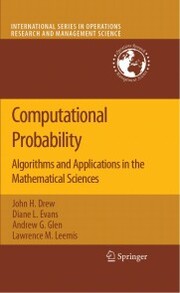-
Zusatztext
-
<P>Computational probability is a set of stochastic methods that has emerged over the past decade that allow researchers and students to solve problems that require exact probability calculations previously considered arduous or intractable.</P><P>Computational Probability is the first book that examines and organizes these computational methods into a systematic treatment. The book is structured around the two categories of problems: (1) Algorithms for Continuous Random Variables has chapters on data structures and algorithms, transformations of random variables, and products of independent random variables. (2) Algorithms for Discrete Random Variables includes data structures and algorithms, sums of independent random variables, and order statistics. The book includes three chapters that emphasize survival analysis and simulation applications. The APPL computational modeling language that gives probabilists a strong software resource for non-trivial problems is available at www.APPLsoftware.com.</P>
-
-
Kurztext
-
Computational probability encompasses data structures and algorithms that have emerged over the past decade that allow researchers and students to focus on a new class of stochastic problems. COMPUTATIONAL PROBABILITY is the first book that examines and presents these computational methods in a systematic manner. The techniques described here address problems that require exact probability calculations, many of which have been considered intractable in the past. The first chapter introduces computational probability analysis, followed by a chapter on the Maple computer algebra system. The third chapter begins the description of APPL, the probability modeling language created by the authors. The book ends with three applications-based chapters that emphasize applications in survival analysis and stochastic simulation.The algorithmic material associated with continuous random variables is presented separately from the material for discrete random variables. Four sample algorithms, which are implemented in APPL, are presented in detail: transformations of continuous random variables, products of independent continuous random variables, sums of independent discrete random variables, and order statistics drawn from discrete populations.The APPL computational modeling language gives the field of probability a strong software resource to use for non-trivial problems and is available at no cost from the authors. APPL is currently being used in applications as wide-ranging as electric power revenue forecasting, analyzing cortical spike trains, and studying the supersonic expansion of hydrogen molecules. Requests for the software have come from fields as diverse as market research, pathology, neurophysiology, statistics, engineering, psychology, physics, medicine, and chemistry.
-
Detailansicht
Computational Probability
eBook - Algorithms and Applications in the Mathematical Sciences, International Series in Operations Research & Management Science
Evans, Diane L/Glen, Andrew G/Leemis, Lawrence et al
ISBN/EAN: 9780387746760
Umbreit-Nr.: 1848913
Sprache:
Englisch
Umfang: 222 S., 1.28 MB
Format in cm:
Einband:
Keine Angabe
Erschienen am 08.01.2008
Auflage: 1/2008
E-Book
Format: PDF
DRM: Digitales Wasserzeichen


